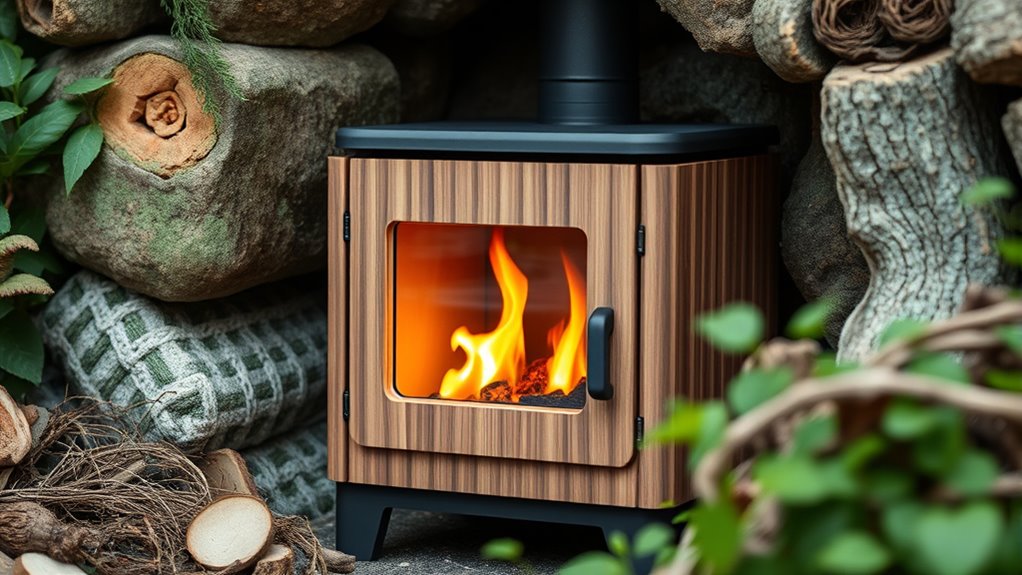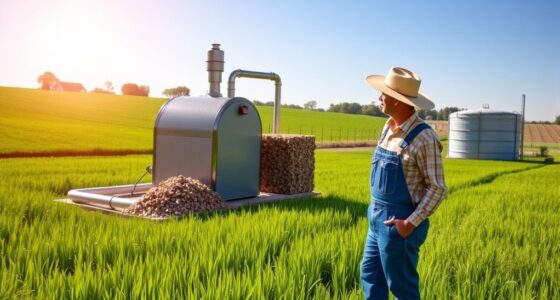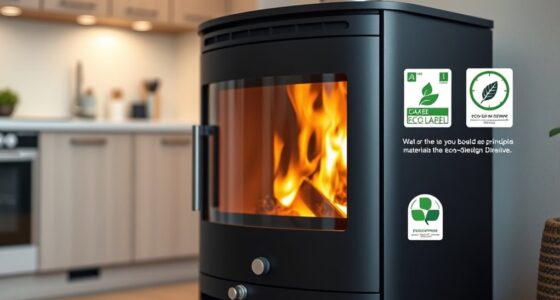To design an eco-friendly small wood stove, focus on using recycled or sustainably sourced materials that are durable and can withstand high temperatures. Optimize energy efficiency with features like airtight doors and insulated chambers, and incorporate secondary combustion to reduce emissions. Keep the design compact and well-sealed for effective heat retention. Prioritizing longevity and low environmental impact helps keep emissions down and efficiency high. Keep exploring to discover more ways to make your stove even greener.
Key Takeaways
- Use recycled or sustainably sourced materials like cast iron, steel, or eco-friendly wood to reduce environmental impact.
- Incorporate insulation and airtight seals to maximize heat retention and energy efficiency.
- Design for secondary combustion or catalytic converters to lower emissions and improve combustion cleanliness.
- Opt for compact, streamlined shapes that minimize material use while optimizing heat output.
- Ensure durable, heat-resistant components to extend stove lifespan and reduce the need for replacement.

Designing a small wood stove with eco-friendly principles means prioritizing efficiency, sustainability, and minimal environmental impact. Your goal is to create a heating solution that uses resources wisely while reducing emissions. To achieve this, focus on selecting sustainable materials that are eco-conscious and durable. Recycled steel or cast iron can be excellent choices because they offer longevity and require less energy to produce compared to new materials. When you choose sustainably sourced wood or biomass fuels, you ensure that your stove’s fuel source is renewable and responsibly harvested, minimizing deforestation and habitat disruption.
Energy efficiency is a cornerstone of eco-design. You want your stove to produce maximum heat with minimum fuel consumption. Incorporate features like a tight-sealing door and an insulated combustion chamber to improve heat retention. These elements prevent heat loss, ensuring that more of the fuel’s energy is converted into warmth rather than wasted. Using a catalytic converter or a secondary combustion chamber can also considerably increase efficiency by burning off excess gases and smoke, reducing emissions and improving fuel utilization. Additionally, designing the airflow pathways carefully ensures ideal combustion, further enhancing energy efficiency. Proper airflow management also supports cleaner emissions and better overall performance.
Maximize heat with tight seals, insulation, and secondary combustion for eco-friendly, efficient wood stove performance.
You should also consider the stove’s size and design to minimize excess material use while maximizing heat output. Compact, streamlined designs not only save on materials but also promote better heat distribution. Using airtight seals and adjustable air vents allows you to control combustion precisely, which helps maintain consistent temperatures and reduces fuel waste. Remember, every aspect of your design should aim to lower emissions and improve efficiency, aligning with eco-friendly principles.
Incorporating sustainable materials and prioritizing energy efficiency doesn’t mean sacrificing performance. Instead, it allows you to build a stove that’s both effective and environmentally responsible. You’ll want to pay attention to the details—such as ensuring the combustion chamber is well-insulated and that the materials used can withstand high temperatures without degrading. This longevity reduces the need for replacements, further decreasing environmental impact over the stove’s lifespan.
Frequently Asked Questions
How Can I Improve the Efficiency of My Small Wood Stove?
To improve your small wood stove’s efficiency, focus on insulation techniques around the stove to retain heat better. Additionally, optimize airflow by adjusting vents and ensuring proper chimney draft, which promotes complete combustion. Regularly clean the flue and remove creosote buildup. These steps help you burn less wood for more heat, making your stove more efficient and eco-friendly.
What Safety Features Are Essential in Eco-Designed Wood Stoves?
You should include ventilation safety features to prevent dangerous buildup of smoke and gases, ensuring safe operation. Childproof locking is essential to keep curious kids away from hot surfaces and controls, reducing accidents. Regularly inspect and maintain your stove’s safety mechanisms, and educate household members on proper use. Combining ventilation safety with childproof locking creates a safer environment, allowing you to enjoy efficient heating without compromising safety.
Are Eco-Friendly Materials Available for Small Wood Stove Construction?
Are eco-friendly materials available for small wood stove construction? Absolutely. You can find sustainable sourcing options like recycled metals and ceramics, plus alternative materials such as bio-based insulations and low-impact firebricks. These choices reduce environmental impact while maintaining safety and efficiency. By opting for eco-friendly materials, you support sustainability and help lower your carbon footprint—making your stove not just functional but also environmentally responsible.
How Do Weather Conditions Affect Stove Performance and Design?
Weather conditions considerably impact your stove’s performance and design. In colder climates, you should focus on climate adaptation by enhancing insulation optimization to retain heat efficiently. Extreme humidity or damp conditions may require materials resistant to moisture, preventing rust and damage. Adjust your stove’s venting and airflow to suit the climate, ensuring consistent heating. Properly considering weather factors helps your stove operate effectively, saving energy and improving safety during varying seasonal conditions.
What Maintenance Practices Maximize Stove Lifespan and Eco-Efficiency?
To maximize your stove’s lifespan and eco-efficiency, you should follow regular cleaning routines and proper ash disposal. Clean the stove and chimney thoroughly to prevent creosote buildup, which can cause dangerous blockages. Dispose of ash safely, ensuring it’s completely cooled and stored away from combustible materials. Regular maintenance keeps your stove running efficiently, reduces emissions, and extends its durability, helping you enjoy cleaner, safer, and more sustainable heating.
Conclusion
By applying these eco-design principles, you can craft a small wood stove that’s both efficient and environmentally friendly. Think of it as planting a seed for sustainability—each mindful decision grows into a greener future. With careful attention to materials and combustion, your stove becomes a beacon of eco-conscious innovation, illuminating your space while respecting our planet. Embrace these guidelines, and let your craftsmanship be the wind that carries positive change.











